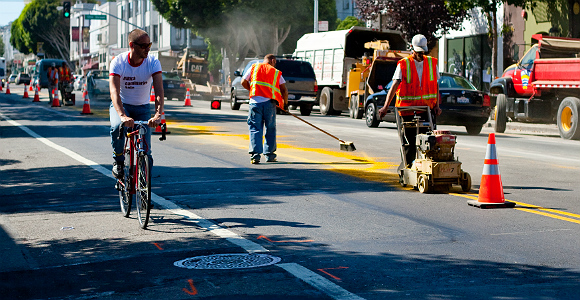
Road work in San Francisco. (Photo Credit: Kate McCarthy/Flickr)
The devil is in the details when it comes to California paying to fill an estimated $59-billion-a-year, infrastructure deficit that’s leaving roads to deteriorate. The good news for cities is they just received a shiny new tool this year in their financing toolbox that could help pay for road repair, transit projects and even affordable housing.
It’s been a bit of a marquee week for those following transportation news, with Governor Brown literally signing off on California’s high-speed rail groundbreaking and the state’s infrastructure financing deficit getting a mention in the State of the State and Governor’s Inauguration speech, and the proposed state budget for the next fiscal year being released.
Unfortunately, the dollar amounts and detailed proposals for filling in that deficit were not included in Brown’s proposed outline of state spending today. But the Governor said they are identifying the problem and have a team working on the issue.
As the Summit and others have noted, however, the state can’t solely rely on general obligation bonds to fill in gaps in infrastructure. That method adds to long-term debt and aren’t permanent funding sources. Plus, federal funds for infrastructure have been unreliable and reducing in size. Also, as Gov. Brown acknowledged, lowering gas usage lowers the amount collected from gas taxes, meaning new ways of funding have to be found.
Something that could help with the situation for local governments, a bill Governor Brown approved last year handed cities a robust, revamped finance tool called Enhanced Infrastructure Financing Districts (EIFD) designed to boost local infrastructure and economic development projects. One of the big benefits of these EIFD’s is that they put local governments in a better position to be able to leverage state resources and get even more money for projects, say financing experts.
“The state doesn’t just hand out money for infrastructure projects,” said Fred Silva, senior fiscal analyst at California Forward and presenter for the EIFD webinar. “It has policy preferences and asks for some local contributions through growth in the local economy. The EIFD public finance authority gives cities the power to better leverage state funds for infrastructure projects.”
Those interested in EIFD’s are invited to attend a free, public webinar hosted by Meeting of the Minds next week on Tuesday at 10:00am PST when a financing expert panel will take attendees through the new authorities available.
The comments from Gov. Brown regarding the funding gap are definitely a welcome statement. But, depending on the budget’s proposals for boosting maintenance of California’s transportation system, communities might see varying degrees of benefits, including upgrades of the highways running through them. That’s why innovative funding tools like EIFD’s will likely enter the conversation more in the next several years.
The webinar next Tuesday will explore the tools available under the EIFD mechanism, such as property tax increment authority, benefit assessments, fees and the ability to enter into public-private partnerships.
The tax increment financing authority, for example, lets cities “invest selected new property tax dollars into the neighborhood instead of into the city’s General Fund.”
Last year, the Summit produced a how-to guide on how local and regional agencies could use the new EIFD authority to invest in everything from sidewalk repair and water infrastructure, to the implementation of sustainable communities plans.
We’ll also be taking a look through the Governor’s budget plan for alignment in Summit Action Team work on infrastructure financing and report back here. And on Monday look out for the Summit’s Roadmap to Prosperity, which will layout three big priorities for 2015 and beyond, including building up the state’s infrastructure and sustainable communities.

